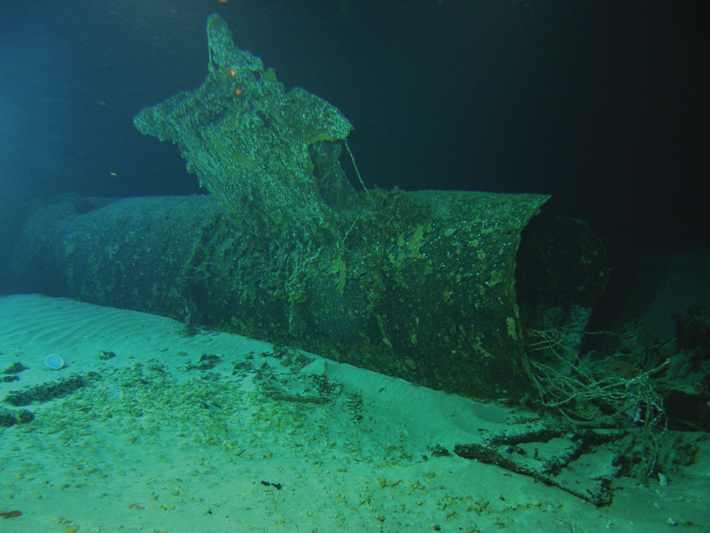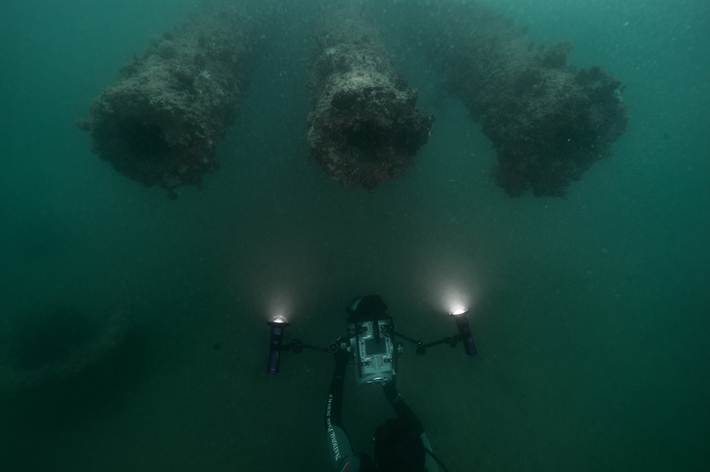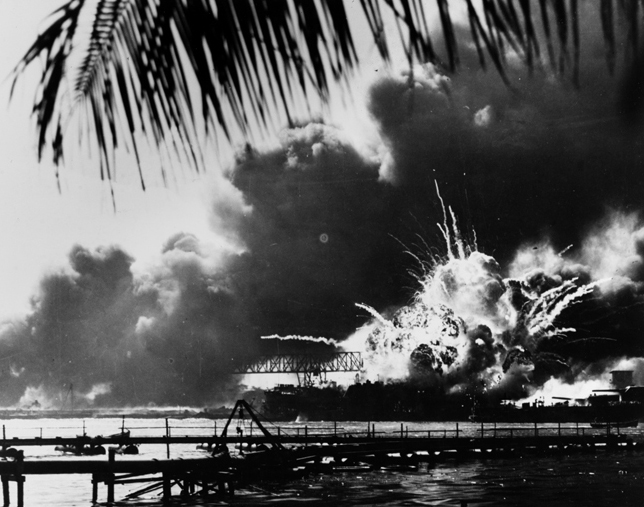The Seaplane
PBY-5 Catalina
January/February 2017
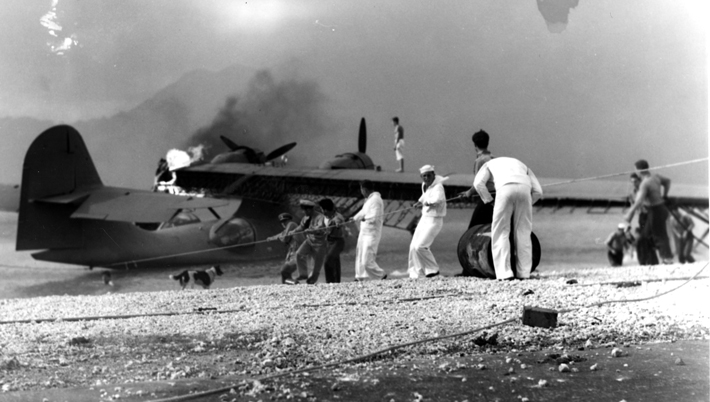
In the attack, 75 percent of the U.S. planes sitting at airfields near Pearl Harbor were damaged or destroyed. For all the aircraft lost—the Japanese lost 59—there is one that can be linked to that morning. Very few people can gain access to it, and even then only with a military escort, since it lies in the water just off Marine Corps Base Hawaii at Kaneohe Bay, on the east side of Oahu. During the war, this was the location of a Naval Air Station for PBY-5 Catalina seaplanes, long-range reconnaissance craft.
The Japanese knew that these planes could track them to their carriers north of the island. The PBY-5s had a range of almost 1,500 miles and could be in the air in minutes. So, just before the general attack, at 7:48 a.m., attacking planes strafed the Naval Air Station with 20 mm incendiary rounds and bombs. Of the 36 planes there, three were out on patrol, six were damaged, and the rest were destroyed. Servicemen at Kaneohe Bay scrambled to put out fires and salvage what they could.
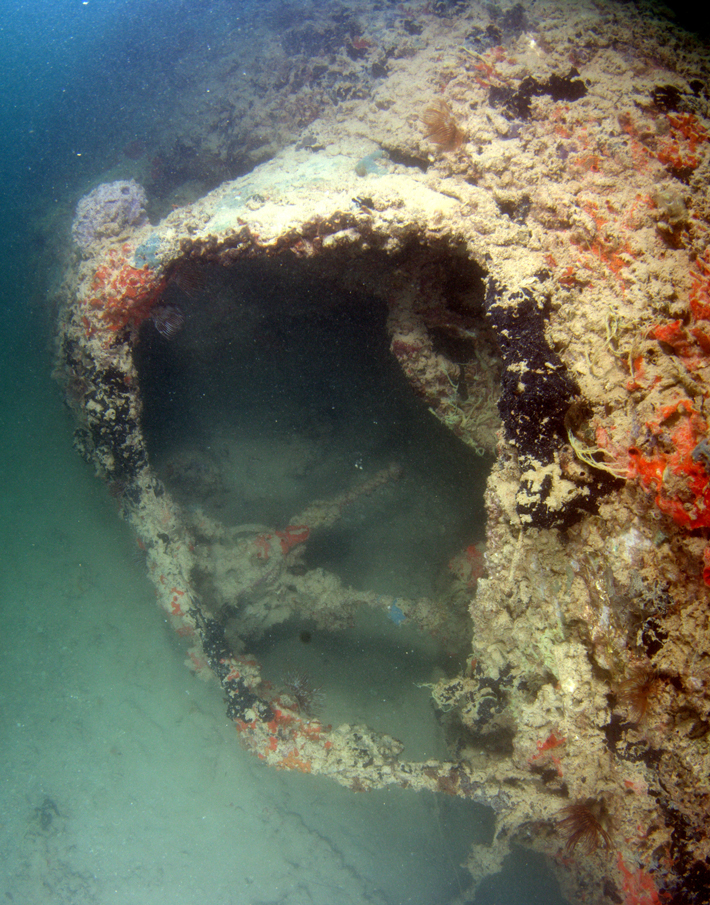 In the 1980s, the mooring area was used for training mine-detecting dolphins. That could be when the battered wreck of one of the PBY-5s was first identified. In 1994, students and archaeologists from the University of Hawaii and East Carolina University surveyed the remains. “It was a good start on the submerged story,” says Hans Van Tilburg, who was on that team and is now a maritime heritage coordinator with NOAA. In 2000, the University of Hawaii returned to the site for surveys that turned up aviation-related scraps, but no other planes. It’s possible that the others had been salvaged or drifted into deeper, murkier water. “Our desire is to get back to the bay and continue looking in deeper water,” says Van Tilburg.
In the 1980s, the mooring area was used for training mine-detecting dolphins. That could be when the battered wreck of one of the PBY-5s was first identified. In 1994, students and archaeologists from the University of Hawaii and East Carolina University surveyed the remains. “It was a good start on the submerged story,” says Hans Van Tilburg, who was on that team and is now a maritime heritage coordinator with NOAA. In 2000, the University of Hawaii returned to the site for surveys that turned up aviation-related scraps, but no other planes. It’s possible that the others had been salvaged or drifted into deeper, murkier water. “Our desire is to get back to the bay and continue looking in deeper water,” says Van Tilburg.
The remains of the plane consist of the forward portion of its fuselage, including the cockpit and turret, which lies on its starboard side in about 30 feet of water, the starboard half of the 105-foot parasol wing, and the fragmented remains of the tail 30 feet away. It is likely that fuel tanks in the center of the wing exploded, but the wrecked seaplane holds telling details about the frantic eight minutes of that initial Japanese attack.
There is a large gash in the port side, just where a propeller would have been. Inside the cockpit, the port throttle is in the forward position. Yet the plane is still attached to its mooring line. This all suggests that an attempt was made to scramble at least one of the planes—but that it didn’t get far. The wreck does not provide evidence of what happened to the pilot, or just how many planes were moored at Kaneohe that morning. Some sources say three, others four, and there are six in a drawing by a Japanese pilot. “Every eyewitness account contradicts the other accounts,” says Van Tilburg. “It’s still a bit of a mystery. But this might be the only plane we know of that we can point to and say, ‘This is a December 7 casualty.’”
Advertisement
IN THIS ISSUE
From the Trenches
Proteins Solve a Hominin Puzzle
Off the Grid
A Pharaoh’s Last Fleet
The Curse of a Medieval English Well
Discovering Terror
Hungry Minds
Guide to the Afterlife
Japan’s Early Anglers
A Removable Feast
Blue Collar in Ancient Peru
The Monkey Effect
Figure of Distinction
Death by Boomerang
Artifact
How not to get frostbite
Advertisement

Recent Issues
-
 May/June 2024
May/June 2024
-
 March/April 2024
March/April 2024
-
 January/February 2024
January/February 2024
-
 November/December 2023
November/December 2023
-
 September/October 2023
September/October 2023
-
 July/August 2023
July/August 2023
-
 May/June 2023
May/June 2023
-
 March/April 2023
March/April 2023
-
 January/February 2023
January/February 2023
-
 November/December 2022
November/December 2022
-
 September/October 2022
September/October 2022
-
 July/August 2022
July/August 2022
-
 May/June 2022
May/June 2022
-
 March/April 2022
March/April 2022
-
 January/February 2022
January/February 2022
-
 November/December 2021
November/December 2021
-
 September/October 2021
September/October 2021
-
 July/August 2021
July/August 2021
-
 May/June 2021
May/June 2021
-
 March/April 2021
March/April 2021
-
 January/February 2021
January/February 2021
-
 November/December 2020
November/December 2020
-
 September/October 2020
September/October 2020
-
 July/August 2020
July/August 2020
-
 May/June 2020
May/June 2020
-
 March/April 2020
March/April 2020
-
 January/February 2020
January/February 2020
-
 November/December 2019
November/December 2019
-
 September/October 2019
September/October 2019
-
 July/August 2019
July/August 2019
-
 May/June 2019
May/June 2019
-
 March/April 2019
March/April 2019
-
 January/February 2019
January/February 2019
-
 November/December 2018
November/December 2018
-
 September/October 2018
September/October 2018
-
 July/August 2018
July/August 2018
-
 May/June 2018
May/June 2018
-
 March/April 2018
March/April 2018
-
 January/February 2018
January/February 2018
-
 November/December 2017
November/December 2017
-
 September/October 2017
September/October 2017
-
 July/August 2017
July/August 2017
-
 May/June 2017
May/June 2017
-
 March/April 2017
March/April 2017
-
 January/February 2017
January/February 2017
-
 November/December 2016
November/December 2016
-
 September/October 2016
September/October 2016
-
 July/August 2016
July/August 2016
-
 May/June 2016
May/June 2016
-
 March/April 2016
March/April 2016
-
 January/February 2016
January/February 2016
-
 November/December 2015
November/December 2015
-
 September/October 2015
September/October 2015
-
 July/August 2015
July/August 2015
-
 May/June 2015
May/June 2015
-
 March/April 2015
March/April 2015
-
 January/February 2015
January/February 2015
-
 November/December 2014
November/December 2014
-
 September/October 2014
September/October 2014
-
 July/August 2014
July/August 2014
-
 May/June 2014
May/June 2014
-
 March/April 2014
March/April 2014
-
 January/February 2014
January/February 2014
-
 November/December 2013
November/December 2013
-
 September/October 2013
September/October 2013
-
 July/August 2013
July/August 2013
-
 May/June 2013
May/June 2013
-
 March/April 2013
March/April 2013
-
 January/February 2013
January/February 2013
-
 November/December 2012
November/December 2012
-
 September/October 2012
September/October 2012
-
 July/August 2012
July/August 2012
-
 May/June 2012
May/June 2012
-
 March/April 2012
March/April 2012
-
 January/February 2012
January/February 2012
-
 November/December 2011
November/December 2011
-
 September/October 2011
September/October 2011
-
 July/August 2011
July/August 2011
-
 May/June 2011
May/June 2011
-
 March/April 2011
March/April 2011
-
 January/February 2011
January/February 2011
Advertisement




